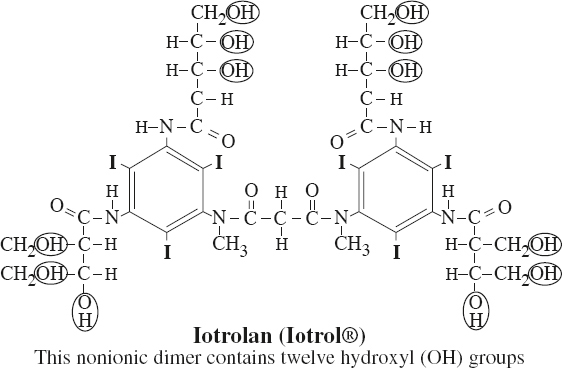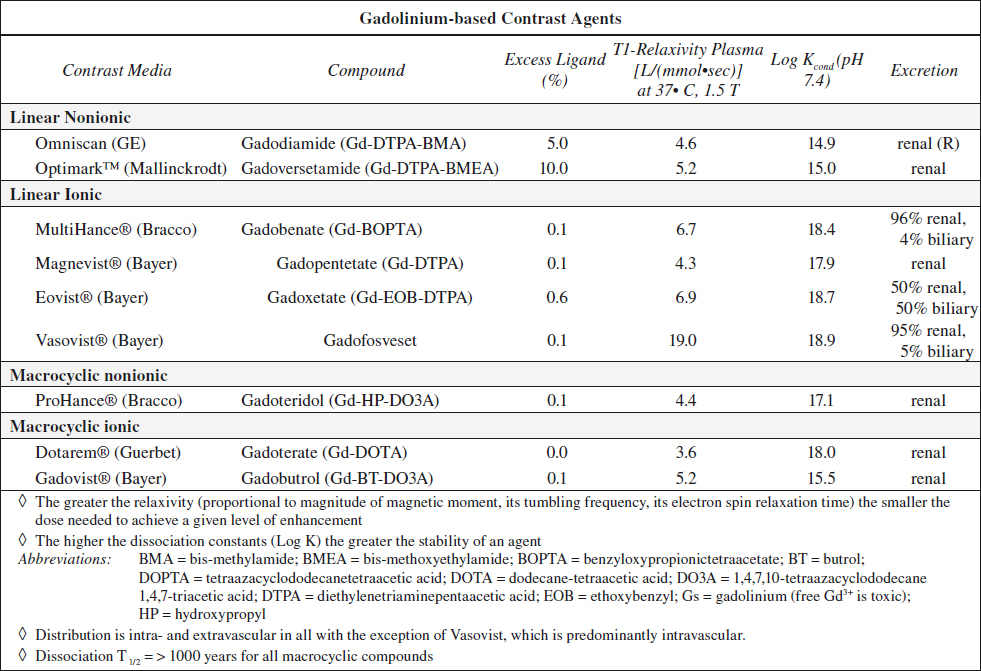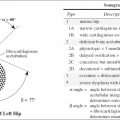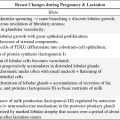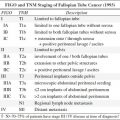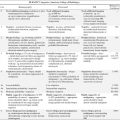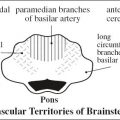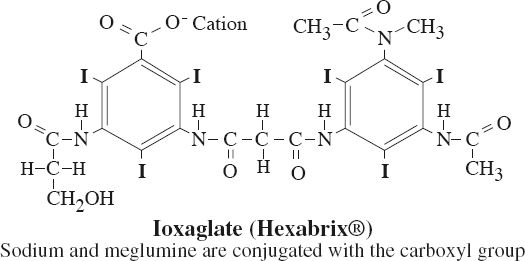
NONIONIC MONOMERS
Construction: benzoic acid carboxyl group replaced by amide; side chains have been modified by adding 4–6 hydroxyl (OH) groups → allows solubility in water
Iodine concentration: up to 350 mg/mL
Iodine-to-particle ratio: 3÷1
Compounds: iohexol, iopamidol, ioversol, iopental, iopromide (Ultravist®), iobitridol (Xenetix®), ioxilan (Oxilan®)
Osmolality: 616–796 mOsm/kg
NONIONIC DIMERS
Construction: contain up to 12 hydroxyl groups → eliminates ionicity, ↑ hydrophilicity, ↓ osmotoxicity, ↑ iodine atoms per molecule
Compounds: iodecol, iotrolan (Isovist®), iodixanol (Visipaque®)
Iodine-to-particle ratio: 6÷1
Osmolality: hypo- / isoosmolar
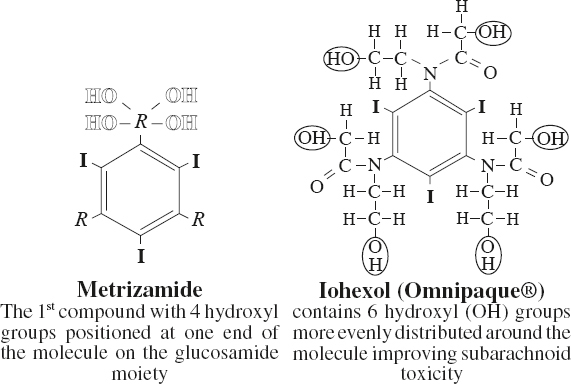
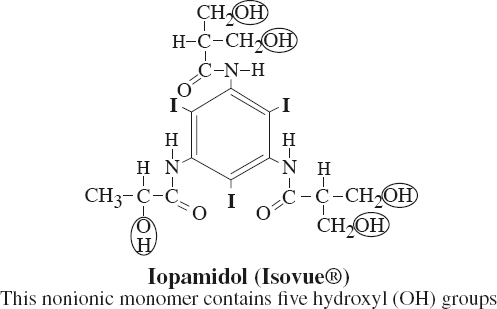
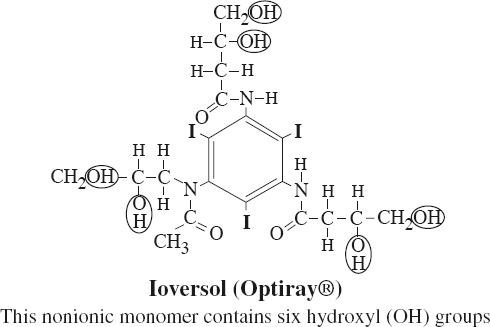
Excretory Urography
Clearance: > 99% of contrast material eliminated through kidney (< 1% through liver, bile, small and large intestines, sweat, tears, saliva); vicarious excretion with renal insult / failure (may be unilateral as in obstructive uropathy)
Halftime: 1–2 hours (doubled in dialysis patients)
Concentration: 60% by weight
(a) Sodium-containing HOCM
√ less distension of collecting system
(b) Meglumine-only HOCM
√ improved distension of collecting system ← decreased tubular resorption of water
(c) LOCM
√ denser nephrogram + slightly denser pyelogram than HOCM ← higher tubular concentration
Angiography
Burning sensation:
(a) intense with concentration of 60–76% HOCM
(b) reduced with concentration of ≤ 30% HOCM / LOCM
◊ Overall incidence of adverse allergic-type reactions is (for unknown reasons) much less with intraarterial than with intravenous use of contrast media!
Venography
(1) Foot / calf discomfort or pressure or burning
(a) ~ 24% with 60% HOCM
(b) ~ 5% with 40% HOCM / 300 mg iodine/mL LOCM
◊ The addition of 10–40 mg lidocaine/50 mL of contrast media decreases patient discomfort!
(2) Postphlebography deep vein thrombosis
(a) 26–48% with 60% HOCM
(b) 0–9% with dilute HOCM / LOCM
◊ Infusion of 150–200 mL of 5% dextrose in water / 5% dextrose in 0.45% saline / heparinized saline through injection site immediately after examination reduces likelihood of DVT!
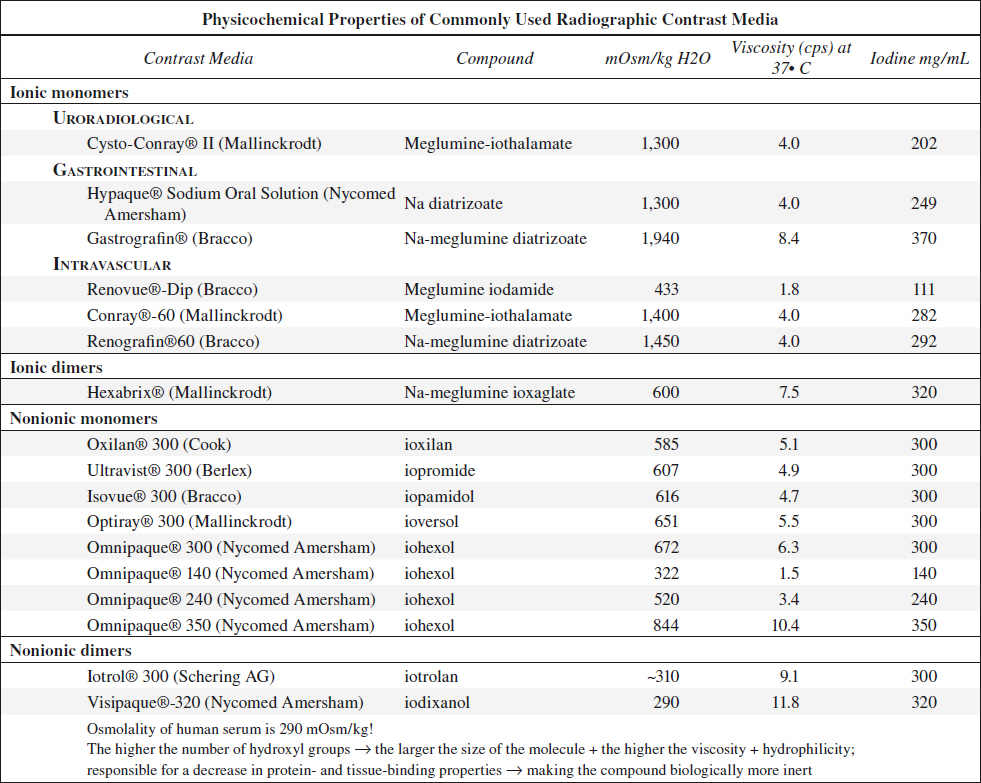
Evaluation of Intravenous Access
1. Chose a catheter appropriate for injection:
› antecubital / large forearm vein ≥ 20-gauge for 3 mL/sec
› peripherally placed 22-gauge for < 1.5 mL/sec
2. Confirm venous return
3. Perform a saline flush
4. Perform a test injection with the power injector esp. for power-injector compatible central venous / peripherally inserted central catheters by observing manufacturer-recommended pressure limits
Contrast Extravasation
= escape of contrast material from vascular lumen + infiltration of interstitial tissue during injection
Incidence: < 1%; no direct correlation with injection flow rate
• may be asymptomatic; edema, erythema
• swelling, tightness, tenderness, stinging, burning pain
| Dx: | (1) Palpate catheter venipuncture site during initial seconds of injection |
(2) Ask patient to report any sensation of pain / swelling at injection site |
Severe Cx (uncommon): compartment syndrome, skin ulceration, tissue necrosis
| Rx: | (1) Elevate affected extremity / site |
(2) Apply a warm / cold compress | |
(3) Monitor for a sufficiently long period | |
(4) Discharge with instructions to watch for symptoms that indicate a need for surgical evaluation | |
(5) Initiate surgical consultation for progressive pain / swelling, decreased capillary refill, paresthesia, skin ulceration / blistering |
ADVERSE CONTRAST REACTIONS
Risk factors:
1. A history of a previous severe reaction to iodinated contrast agent increases the overall risk of a subsequent reaction by about 5- to 6-fold.
2. All severe allergies and reactions (to medications and food)
There is NO specific link between shellfish allergy and allergy to contrast agents.
3. History of asthma / bronchospasm / atopy
4. History of cardiac / renal disease
5. Age > 60 years OR < 5 years
A. Nonidiosyncratic (= dose-related) reactions
Cause: direct chemotoxic / hyperosmolar effect
• nausea, vomiting; cardiac arrhythmia; renal failure
• pulmonary edema; cardiovascular collapse
B. Idiosyncratic (= anaphylactoid) reactions
= reactions occurring unpredictably + independently of dose / concentration = not a true antigen-IgE antibody-mediated reaction nor a reaction to iodine / iodide
Cause: unknown
• hives, itching; facial / laryngeal edema
• bronchospasm, respiratory collapse; circulatory collapse
C. Delayed reactions
• erythematous rashes, pruritus, fever, chills, flulike symptoms
• joint pain, loss of appetite, taste disturbance, headache
• fatigue, depression, abdominal pain, constipation, diarrhea
Significant underlying medical conditions
(b) cardiac disease
(c) blood dyscrasias
(d) pheochromocytoma
(e) ↑ symptoms with COPD plus pulmonary hypertension
(f) ↑ sickling in patients with sickle-cell disease
◊ Approximately 20–40% of population are at increased risk for adverse reaction to contrast media!
◊ In patients with adverse reactions to HOCM repeated reactions will be lowered to 5% by using LOCM
◊ No direct correlation / association to povidone-iodine skin cleansing solution (Betadine®)
Assessment of Patients before Contrast Injection
A. General status
Assess hemodynamic, neurologic, general nutritional, anxiety status
B. History of significant allergies
1. Prior anaphylactic response to any allergen
2. Asthma
C. Renal disease
1. Renal dysfunction: obtain baseline BUN + creatinine
2. Diabetes mellitus
3. Multiple myeloma
◊ Hydrate patients and limit contrast dose!
D. Cardiac disease
1. Angina
2. CHF with minimal exertion
3. Severe aortic stenosis
4. Primary pulmonary hypertension
5. Severe cardiomyopathy
◊ Limit contrast dose!
NEPHROTOXICITY
= CONTRAST-INDUCED NEPHROTOXICITY (CIN)
= sudden deterioration of renal function after recent IV administration of contrast media in the absence of another nephrotoxic event
Indications for Obtaining Creatinine Levels
A. IODINATED CONTRAST AGENTS

Stay updated, free articles. Join our Telegram channel

Full access? Get Clinical Tree


